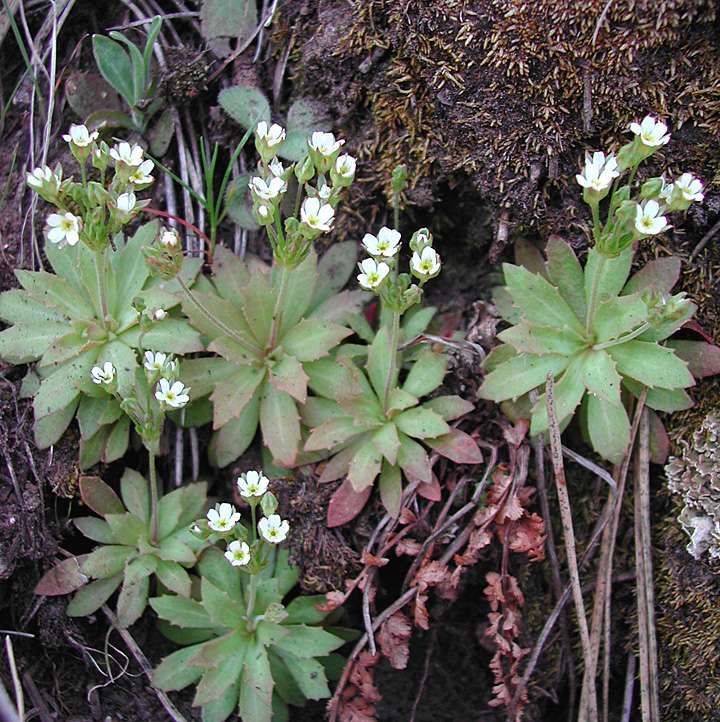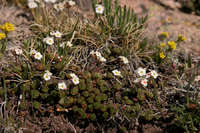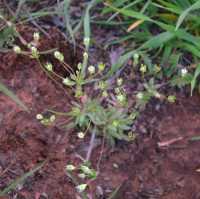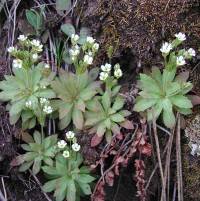Herbs usually annual or perennial, rarely biennial, sometimes cushion- or mat-forming, rarely slightly succulent. Rhizomes absent; roots fibrous or a slender taproot. Stems ascending, simple. Leaves in single or multiple basal rosettes, simple; petiole absent or obscure, slightly winged; blade lanceolate to spatulate or cuneate, base attenuate, cuneate, or truncate, margins entire or moderately dentate, apex acute to obtuse (often dentate), surfaces usually hairy, hairs grayish white, simple or forked. Scapes 1-25. Inflorescences umbels, 2-20-flowered, involucrate; bracts 1-10. Pedicels absent or erect to arcuate, elongating with age. Flowers homostylous; sepals 5, green, calyx broadly campanulate to subglobose or hemispheric, ± 5-angled, not keeled, glabrous, pilose, or puberulent, lobes shorter than tube; petals 5, white, sometimes fading to pink in age [pink to shades of red], corolla campanulate to salverform, tube yellow, ± inflated, lobes shorter than tube, apex emarginate to entire; stamens included; filaments indistinct, very short; anthers not connivent. Capsules globose to subglobose, valvate, dehiscent nearly to base. Seeds usually 3-4 in perennial species, 20-50+ in annual species, brown, 4-angled to somewhat trigonous, reticulate to almost smooth. x = 10.
Androsace is chiefly Eurasian, with its greatest diversity in China, where over 70 species occur. It is a popular rock garden genus with many horticultural representatives. One of these, A. maxima, an annual Eurasian species growing as a single rosette, was reported in the late 1800s as an introduction near Yonkers, New York. We have no recent records that suggest this was anything more than an ephemeral horticultural escape.
PLANT: Annuals or short-lived perennials with upright, clustered stems.
LEAVES: basal; margins entire or dentate.
INFLORESCENCE: a scapose umbel.
FLOWERS: white or pink; calyx lobed ca. ½ its length, the lobes 5; corolla lobed ca. ½ its length, the lobes 5, the apices obtuse; stamens 5; ovary superior.
FRUITS: valvate.
NOTES: Ca. 100 spp. in north temperate regions. Although some taxonomists recognize several vars. within the two AZ species, the characters used to distinguish the vars. frequently intergrade. Therefore, no attempt is made to distinguish them here. (Greek: some sea plant). Robbins, G. T. 1944. Amer. Midl. Naturalist 32:137-163.
REFERENCES: Cholewa Anita F. 1992. Primulaceae. Ariz.-Nev. Acad. Sci. 26(1)2
Cal-tube obconic, equaling or exceeding the triangular lobes; cor salverform, constricted at the throat; stamens included; style very short; stigma capitate; capsule 5-valved, enclosed in the persistent cal; small winter-annuals with a rosette of basal lvs and one to several scapes bearing terminal, involucrate umbels of very small fls. 100, N. Temp. and Arctic.
Gleason, Henry A. & Cronquist, Arthur J. 1991. Manual of vascular plants of northeastern United States and adjacent Canada. lxxv + 910 pp.
©The New York Botanical Garden. All rights reserved. Used by permission.






